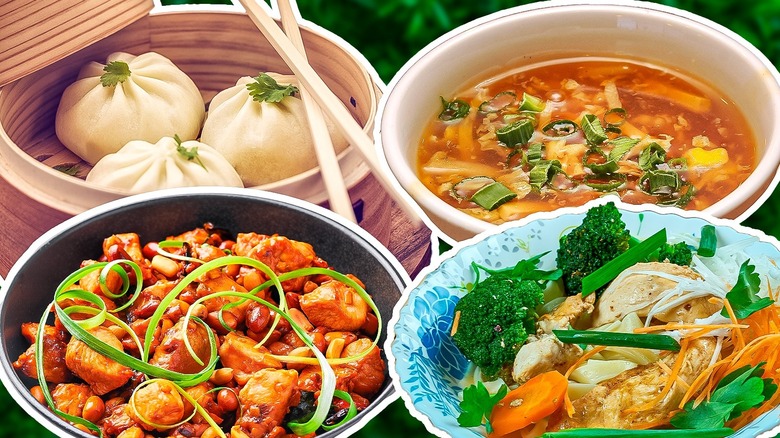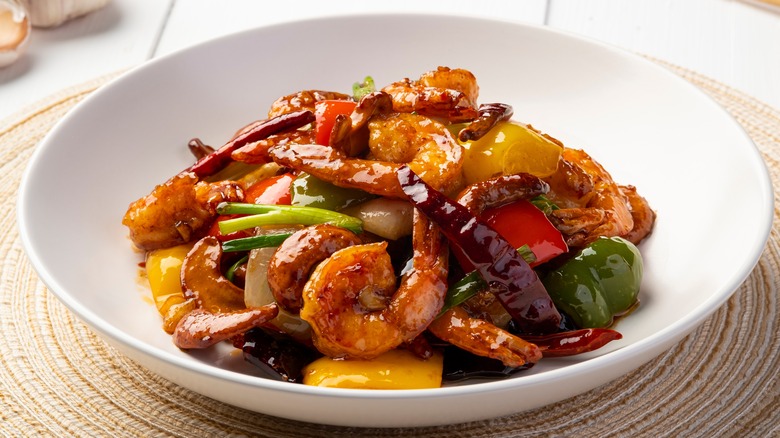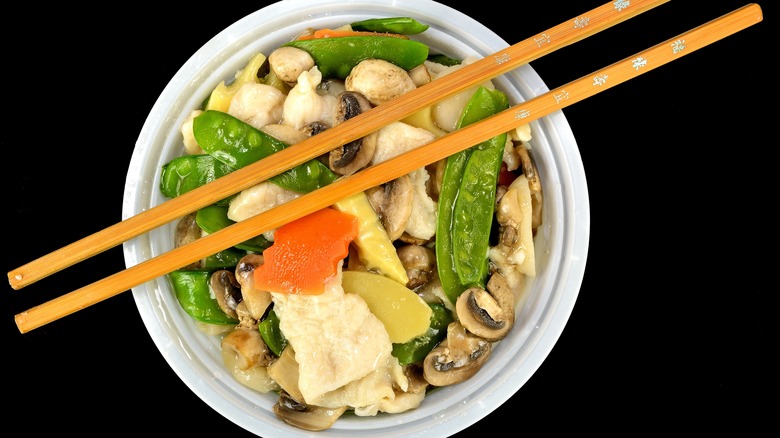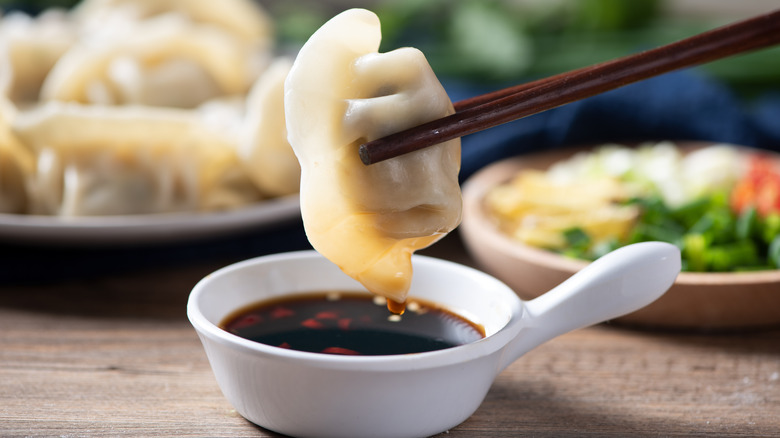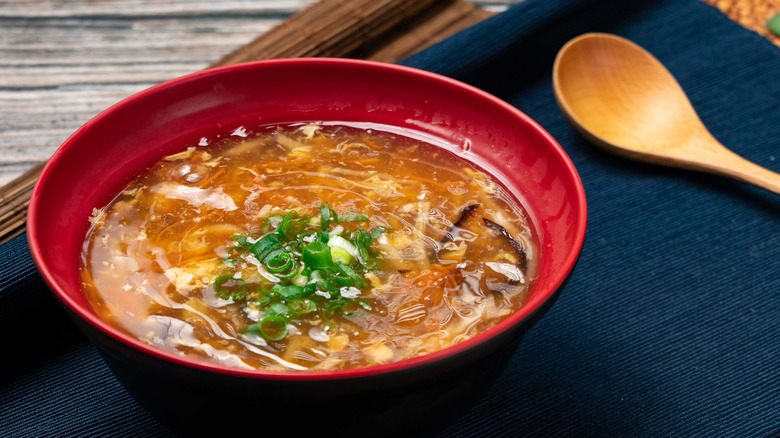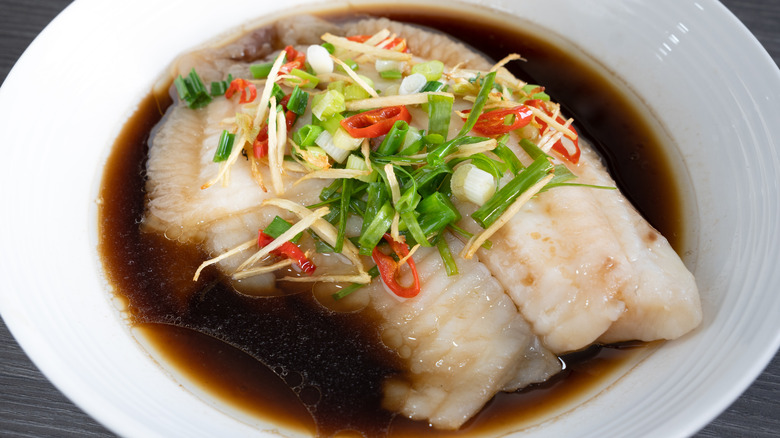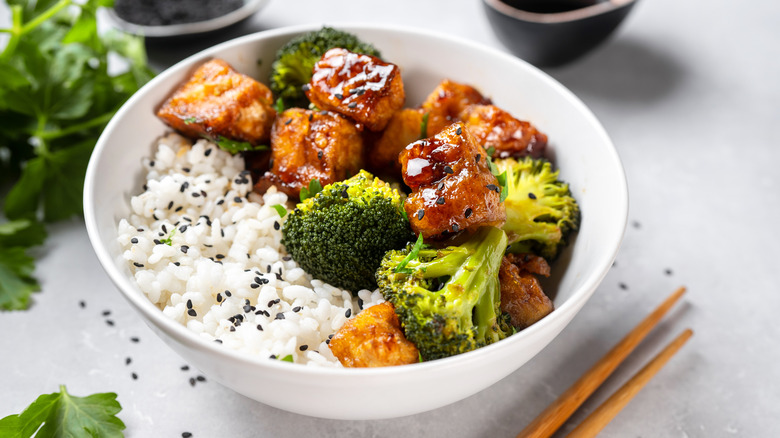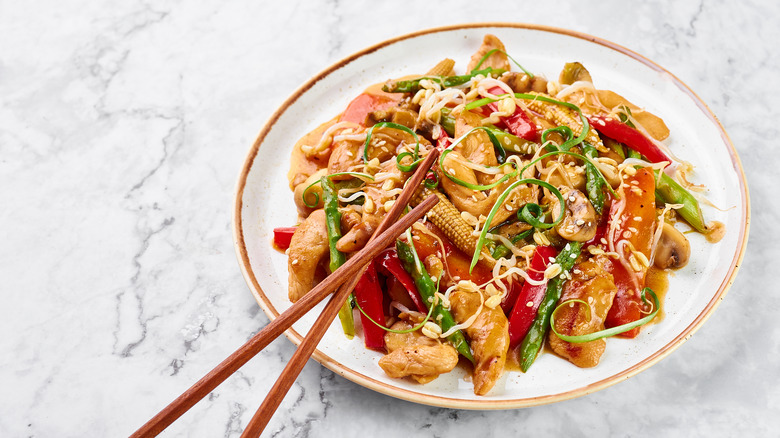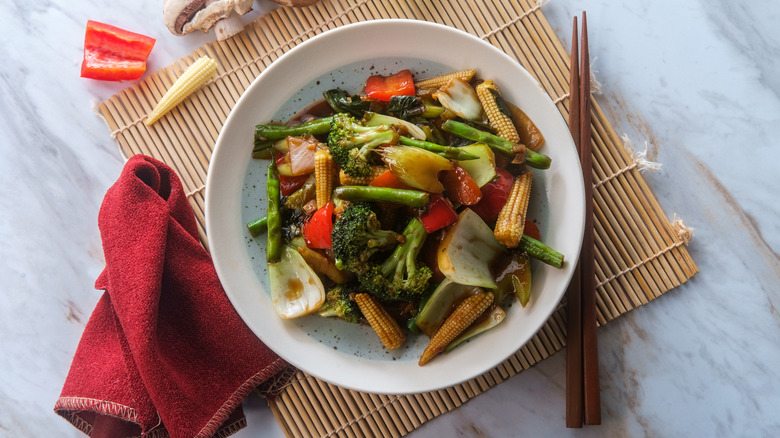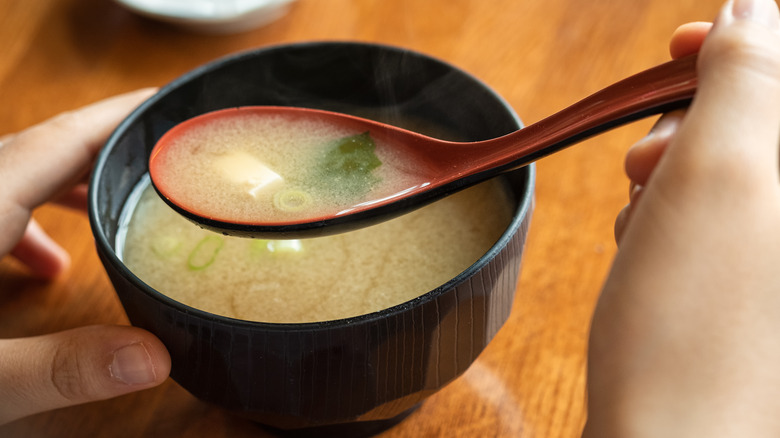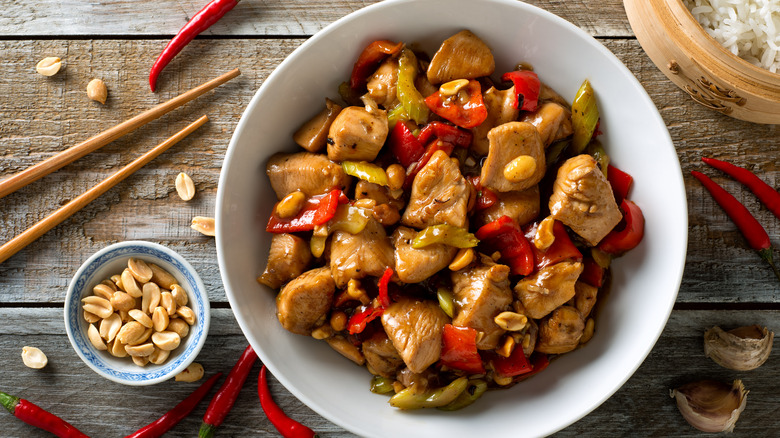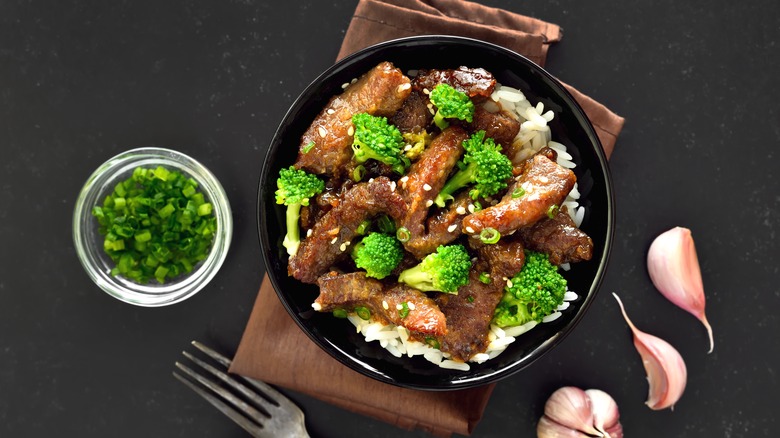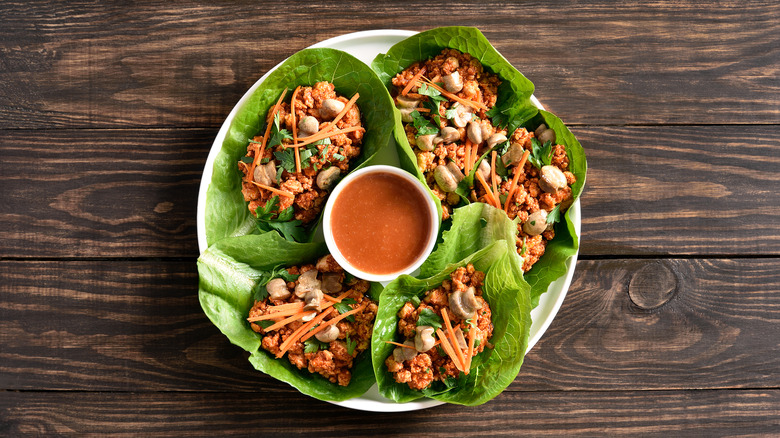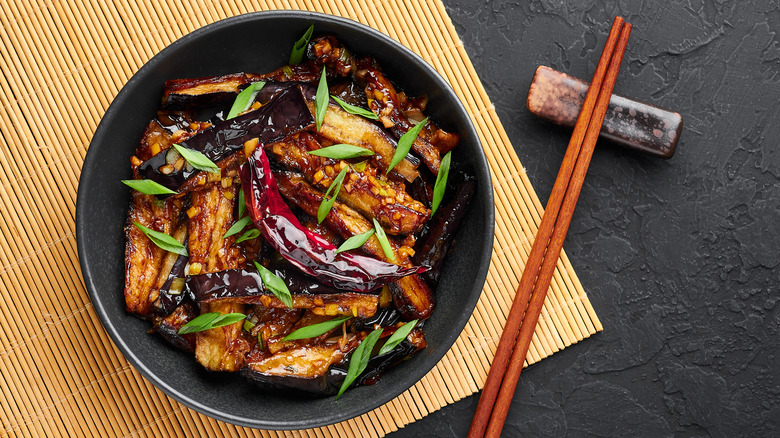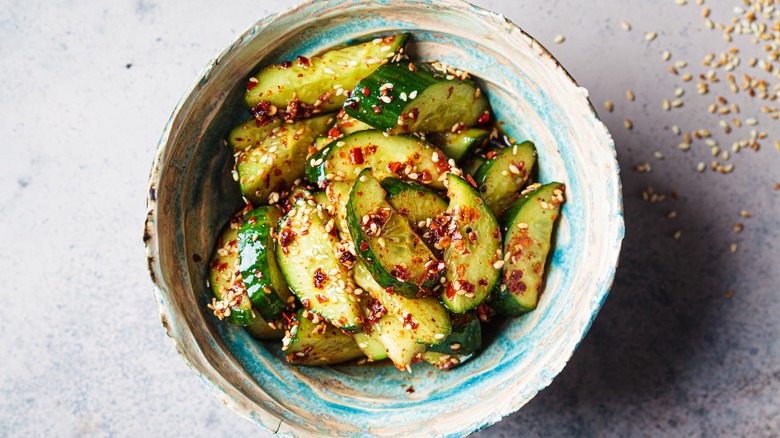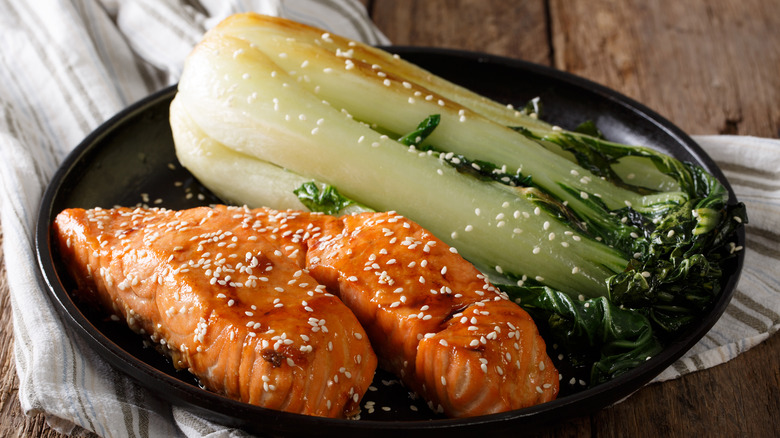15 Healthiest Chinese Food Takeout Orders
When the urge for Chinese takeout strikes, there's little point in fighting it. With menus and dishes that positively burst with flavor, Chinese food is a staple choice around the world when the idea of cooking feels daunting. But there's no denying that the reputation of Chinese takeout isn't exactly sparkling.
The cuisine has long been plagued with accusations that some of its ingredients, namely MSG (or monosodium glutamate), cause unpleasant symptoms upon consumption. This outdated myth has been fought by multiple high-profile personalities, and even the U.S. Food & Drug Administration categorizes it as being generally recognized as safe to eat. So why might you not feel your best after Chinese takeout? It might have to do with what you're ordering.
Like any other cuisine, Chinese takeout has a range of options that can be high in fat, sugar, and salt, which are often used quite liberally. But the truth is that there are dozens of options on your takeout menu that place an emphasis on healthy cooking methods and fresh flavors. So if you're looking to keep your meal a little healthier next time you're ordering takeout, what should you choose? We've got all our favorites right here.
Shrimp in black bean sauce
Black bean sauce is made from fermented black beans combined with garlic, shallots, and additional seasonings, giving any dish a funky, sweet, umami-packed punch of flavor. The result is achieved through the balance of ingredients and not by using loads of salt, sugar, or fat.
As a result, a lot of dishes seasoned with black bean sauce are a great choice if you want to go hard on flavor without having too many unhealthy ingredients. If you want to keep it super healthy, opt for shrimp as a nutrient-rich protein source. Loaded with omega-3 fatty acids, this seafood option can be beneficial for heart health (via Healthline). Additionally, shrimp contains an antioxidant called astaxanthin, which may have an anti-inflammatory effect.
Shrimp in black bean sauce is usually prepared without batter, nor is it deep-fried. Instead, the protein is usually stir-fried in a little oil before being combined with the sauce. To make this dish even more nutritious, ask for extra vegetables with the shrimp to give you a boost of vitamins and fiber. Eat it alongside steamed white rice — or brown rice to make your meal even healthier.
Moo goo gai pan
It can be tempting to fall back on your standard order when getting Chinese takeout, but if you're in the market for something new and healthy, take a chance on moo goo gai pan. This meat-based dish is one of the simplest and most nutritious options you can grab from your local restaurant. Moo goo gai pan is composed of pieces of chicken breast that are lightly sauteed with mushrooms, which together give the dish its name: gai pan translates to chicken slices in Cantonese, while moo goo means mushrooms.
Along with these two core ingredients, moo goo gai pan frequently contains a host of other fresh vegetables, like water chestnuts, snow peas, carrots, and bamboo shoots. The whole combination is tied together with a light sauce that doesn't feel too gloopy or rich. Ordering this dish gives you a nutrient-rich meal with vitamins, minerals, and fiber supplied in large quantities from the vegetables. As well, an excellent amount of lean protein and amino acids are provided by the chicken breast. Combine it with a simple bowl of rice or plain noodles, and you've got yourself a hearty meal.
Steamed vegetable dumplings
We have yet to meet a person who doesn't like dumplings, and few places do them better than Chinese takeouts. But if you're trying to eat healthier, restaurant dumplings can be a tricky proposition, as they're often fried in copious amounts of oil, or contain fatty, salty fillings.
By changing up the flavor and cooking style of your dumplings, you can convert them into a healthy dish. Cooking the dumplings with steam allows restaurants to avoid using too much fat to prepare them. Accredited dietitian Anika Rouf recommends considering the filling, portion size, and any additional condiments when assessing the healthiness of steamed or boiled dumplings (via 9Honey).
Rouf notes that dumplings filled with vegetables and seafood are better options as they're less energy-dense. They'll manage to satisfy your appetite without overdoing it. If you're a big fan of meat dumplings, she recommends trying to limit your portion and accompanying them with a side of steamed vegetables.
Hot and sour soup
Soups are an underrated element of Chinese takeout cuisine. Opting for soup is not only a great way to try something new, but it easily replaces your standard appetizer or side dish with something less fatty and just as filling. Most soups at American-Chinese restaurants will be less calorie-dense than the deep-fried starters on the menu, but if you want to keep it punchy yet light, hot and sour soup is the way to go.
This Sichuan soup is a flavor sensation that obtains its dynamic profile through a combination of chicken broth, vinegar, ginger, soy sauce, and white pepper. Hot and sour soups usually contain vegetables, with bamboo shoots making a frequent appearance. Protein can be added to turn it into a more substantial meal.
This broth-based dish is not only hydrating thanks to its high liquid content, but it's also low in calories, with each cup containing around 90 calories. There's also some fiber provided by the vegetables and a relatively low-fat content per serving. Bear in mind though, that some Chinese takeout joints can use cornstarch to thicken their soups, which will increase the carbohydrate content.
Steamed fish with ginger and soy sauce
Does it get much healthier or more delicious than steamed fish? We don't think so. Steaming is the perfect way to cook the delicate flesh of fish meat, keeping it tender and moist while gently elevating its natural flavors. By steaming fish, restaurants are able to reduce unnecessary fat content and keep the focus on the protein. Not to mention, they can avoid some of the loss of nutrients that can occur when cooking at higher heat.
Chinese takeout restaurants often have several options on their menus, but if you want maximum flavor, steamed fish with ginger and soy sauce is where it's at. Restaurants use white-fleshed fish like tilapia or flounder and gently steam it until it's just cooked. Once it's done, they saute ginger (potentially alongside other aromatics like scallions or garlic), before adding soy sauce and sometimes a touch of sugar. The soy-ginger mixture is then poured over the fish, creating a medley of flavors that's totally irresistible. Grab an order of this alongside some white rice, which is the perfect vehicle for soaking up all of that delicious sauce.
Tofu and broccoli stir-fry
Of all the qualities of Chinese cuisine, its greatest feature might be creating huge amounts of flavor with just a few ingredients. And that's exactly the case with a tofu and broccoli stir fry. This dish consists of two main components — tofu and broccoli — fried in a bit of oil and mixed in a well-balanced sauce made with soy, ginger, garlic, and sesame.
This plant-based dish is one of the best items for vegetarians and vegans to order on a Chinese takeout menu, and it's positively bursting with nutrients. By choosing tofu, you get an excellent protein source without any of the saturated fats that come with some meats. "It's a complete protein, which means it boasts all the essential amino acids that our body needs to build and heal. It's also rich in minerals like calcium, and has a bit of fiber in it," says registered dietitian Sapna Bhalsod (via HuffPost). The broccoli, meanwhile, adds more fiber and contains properties that may benefit your heart, eye, and immune health, per BBC Good Food.
Chop suey
It's easy to think of chop suey as chow mein's slightly less popular sibling, but we think it deserves a closer look. The difference between chop suey and chow mein is subtle but distinct. Chow mein, the quintessential Chinese takeout noodle dish, is made by stir-frying egg noodles with meat and vegetables (and, occasionally, frying the proteins and vegetables to serve over deep-fried noodles). Chop suey, on the other hand, keeps the components slightly more separate, by first frying the vegetables and protein in a flavorful sauce, and then spooning them over cooked rice or noodles.
Chop suey has the edge over chow mein in terms of health, because the carbohydrate element of the dish is left unfried, meaning that the meal has less oil. Additionally, by removing the noodles from the wok, there's more space to load up chop suey with crunchy, fresh vegetables. To make it even healthier, ask your Chinese takeout restaurant if they can reduce the amount of sauce used, to cut down on the sodium and potential sugar in the dish.
Buddha's Delight
We just love it when our takeout dishes have an intriguing name while simultaneously being utterly delectable, and Buddha's Delight delivers on both fronts. This dish, also known as lo han jai, is a vegetable-packed affair that also carries a rich symbolism from its multiple ingredients. Typically made with 10 or more vegetables, Buddha's Delight is a vegetarian stew that's commonly served at the start of the Chinese New Year. Each vegetable included represents a different symbol of good fortune for the coming year. Snow peas, for example, are representative of unity and togetherness, whereas carrots sliced into rounds may symbolize wealth and good luck.
The vegetables are all simmered together in a salty-sweet broth made from soy sauce and a little sugar. Protein can also be added by including tofu and peanuts. Buddha's Delight's emphasis on vegetables and vegetarian ingredients makes it a nutritious and wholesome option, and it's packed with vitamins, minerals, and antioxidants from the different components. If a Chinese takeout dish is also going to bring you some good vibes for the year ahead, it's a no-brainer to order.
Miso soup
Miso soup may not strictly be a Chinese takeout staple, being far more common in Japanese eateries, but it's become increasingly frequent on American-Chinese and Asian-fusion restaurant menus. And, honestly, we get it. Miso soup is a uniquely delicious food, incorporating the fermented, salty flavors of miso paste, which gives the clear broth complexity and richness without the use of copious fat, sugar, or salt.
And luckily, it's also one of the healthiest items you can order at a Chinese takeout. As a probiotic, miso is excellent for your gut health and helps your digestive system maintain its natural level of microbes (per the Cleveland Clinic). It's also loaded with useful vitamins and minerals, ensuring that you're eating a meal that's nutritious and full of goodness. Crucially, miso soup is low in fat and calories, which makes it a healthy and light way to start your meal. Adding tofu can also boost the protein content, which makes it even more filling.
Kung pao chicken
Kung pao chicken is one of our all-time favorites on a Chinese takeout menu, and we're not alone. Ask anyone to name the Chinese dishes they're most familiar with and kung pao chicken will likely be mentioned repeatedly. But did you know that it's also one of the healthier options you can grab at your local takeout?
While kung pao chicken is similar in appearance and flavor to other sauce-based favorites like sweet and sour or General Tso's chicken, the chicken here is cooked without being battered. This makes a world of difference since the meat has no opportunity to soak up huge amounts of fat as it cooks. Kung pao chicken is an altogether lighter proposition, that still has a flavorful, spicy sauce, laced with chili peppers and peppercorns.
Thanks to the large amount of meat and peanuts you get in each serving, kung pao chicken is also super-satisfying and will keep you full for hours. This dish frequently includes green and red peppers, giving you an extra shot of fiber and vitamins. Just remember that kung pao chicken can sometimes be on the saltier side, so ask if you can get less soy sauce or salt in your dish.
Beef and broccoli in garlic sauce
Chinese takeouts have dozens of variations of stir-fries, each one championing a different flavor profile. We don't blame you if you find the enormous selection a bit daunting. But if you're feeling overwhelmed, take comfort in the fact that some of the classics, like beef and broccoli in garlic sauce, are not just delicious but also pretty good for you.
Beef and broccoli in garlic sauce is pretty much exactly what it says on the tin. Strips of beef are stir-fried with florets of broccoli, alongside garlic and ginger. The dish is then made saucier by adding some soy sauce, Shaoxing rice wine, and a cornstarch solution to thicken it up. It's often finished off with a sprinkling of sesame seeds and a dash of sesame oil.
The dish is fragrant, moreish, and pretty wholesome overall. While beef and other red meats are often placed in a negative light, in moderation, unprocessed beef can be a key part of a healthy diet. Beef is one of the best sources of protein out there, and it's especially high in iron, which is vital for blood health and preventing anemia (via Healthline). As well, all of that garlic won't just do wonders for your tastebuds, but for your immune system too, thanks to its antimicrobial properties, per BBC Good Food.
Chicken lettuce wraps
If you're following a low-carb diet, ordering Chinese takeout can pose some serious problems. American-Chinese food has a tendency of being pretty high in carbohydrates, and often from sources that you might not expect. Sauce-based dishes contain a fair amount of sugar, even when they don't taste particularly sweet, and the addition of cornstarch to thicken broths and coat meats can also raise your meal's carb count.
By ordering chicken lettuce wraps, you should be able to keep your meal low-carb without losing out on the flavor. Chicken lettuce wraps are pretty much what they sound like. Ground chicken is stir-fried in a wok until brown, sometimes with vegetables like onion and red pepper, before being flavored with garlic, ginger, chili, and soy sauce. Once everything's cooked through, the chicken mixture is loaded into lettuce leaves and topped with chopped peanuts. The end result is kind of like a Chinese taco, but it's carb-free and full of nutrients from the chicken and lettuce. Honestly, even if you're not doing low-carb, we recommend you try this one out for size.
Chinese eggplant in garlic sauce
If you've ever had Chinese eggplant, you're unlikely to want to order anything else from your local Chinese restaurant again. These vegetables are a smaller, thinner version of the eggplants you may be used to, but they're somehow even more delicious, with a mild sweetness and light smokiness that makes them totally mouth-watering. Chinese eggplant in garlic sauce builds on this gentle flavor profile and amps it up with powerful punches of garlic, chili, and ginger. The resultant dish is lightly saucy, big on taste, and full of soft, squishy eggplant pieces that make us want to become full-time vegetarians.
And that's all before you consider how good eggplants are for you. The deep purple pigment that gives eggplant its distinctive color is also an antioxidant and may have a strong counter-effect against cancer-causing free radicals in the body, says WebMD. Other antioxidants in eggplant may help reduce bad cholesterol in the blood, and the vegetables are also fiber-heavy and vitamin-rich while remaining low in calories. Honestly, we can't see any negatives to ordering this dish.
Chinese cucumber salad
Chinese takeout cuisine isn't often known for its salads, but if you look hard enough, you might spot a few on the menu that you shouldn't miss. Chinese cucumber salad is a must-try side dish that won't add loads of fat or calories to your daily intake. This bright dish puts the fresh taste of cucumber front and center and contrasts the coolness with a hint of spice. Diced or smashed cucumbers are combined with sesame and chili oil, alongside fresh garlic, vinegar, a pinch of sugar, and a little soy sauce or salt to bring out the savory flavors. Everything melds together to create a layered, sprightly salad.
It definitely helps that the star of the dish, cucumber, is so darn good for you. "Cucumbers can help with disease prevention, weight management, and digestion," states registered dietitian Amber Sommer, per the Cleveland Clinic. Cucumbers are also especially high in vitamin K, which can be particularly beneficial for bone health and instrumental in helping your body use calcium. Additionally, cucumbers are high in water, meaning that this salad has a hydrating effect.
Baked salmon
Opting for fish at a Chinese restaurant is often a good way to get some quality protein, and it's hard to do much better than baked salmon. Like steaming, baking is a fantastic way to cook fish without using too much fat. Baked salmon is usually coated or marinated with flavors like garlic, chili, ginger, and sesame, and then served dry, without too much sauce. This has the benefit of packing all of the flavors into the fish itself but also avoids coating it in a sugar-packed, carbohydrate-filled sauce.
It helps that salmon is among the healthiest fish out there. Salmon is abundant in omega-3 fatty acids, which can help preserve heart and brain function and keep your memory sharp, per BBC Good Food. As well, salmon and other oily fish may have an anti-inflammatory effect, making them instrumental in keeping chronic diseases at bay. But the main feature about salmon? It's delicious — completely, undeniably delicious. So even if you're not trying to eat healthy, we'd recommend giving this dish a try.
